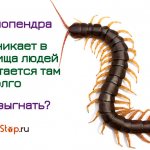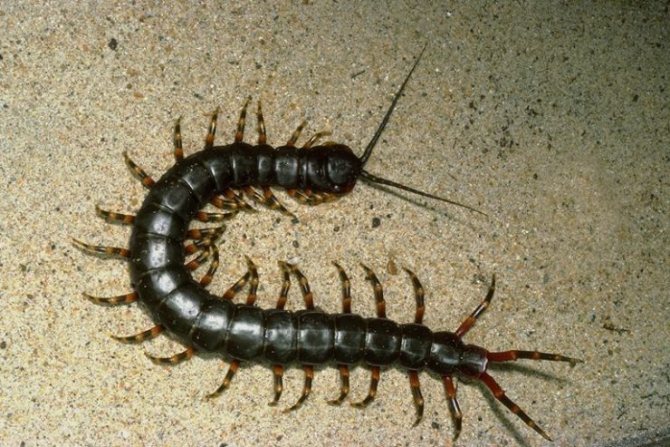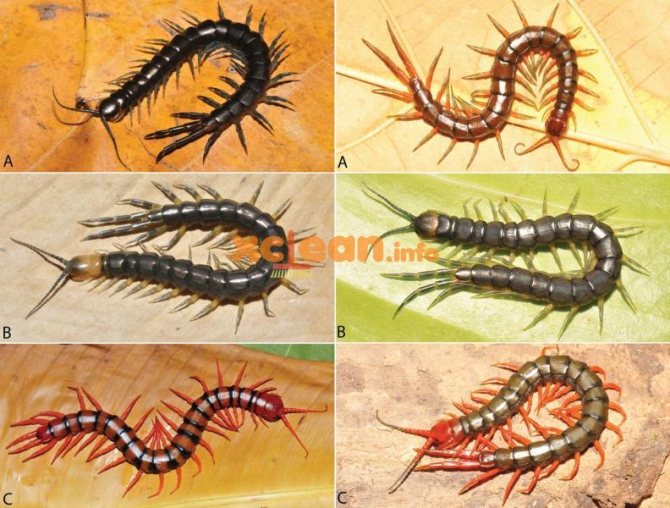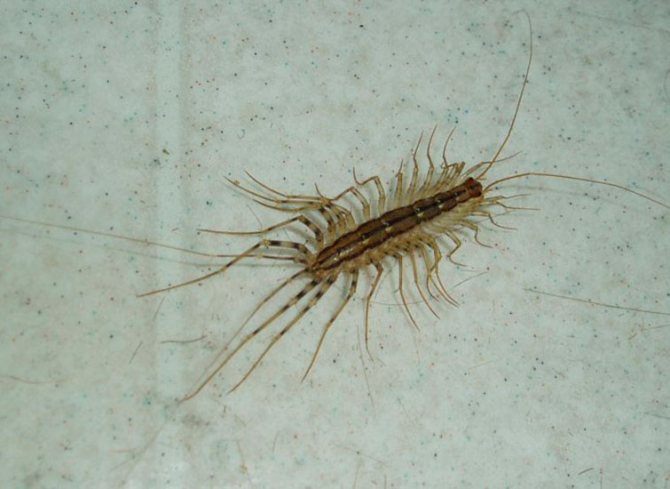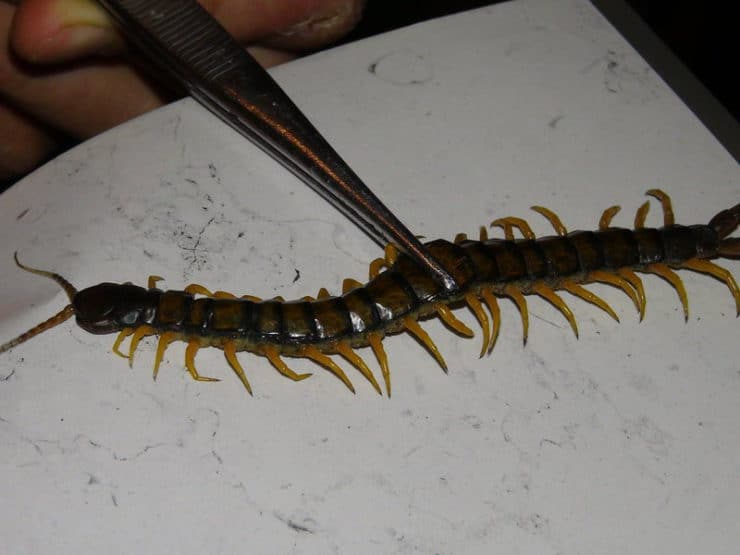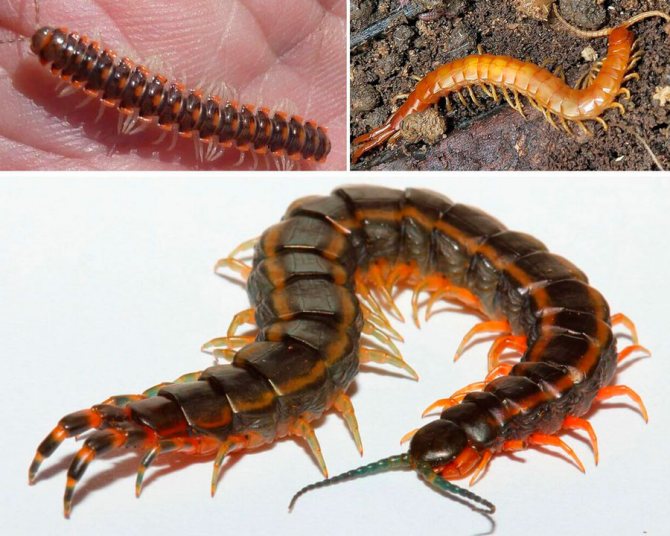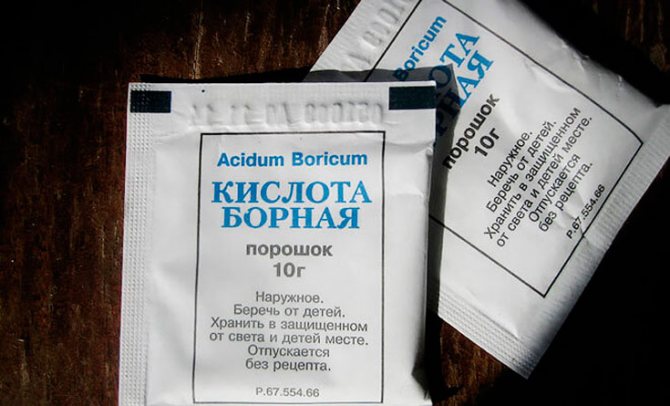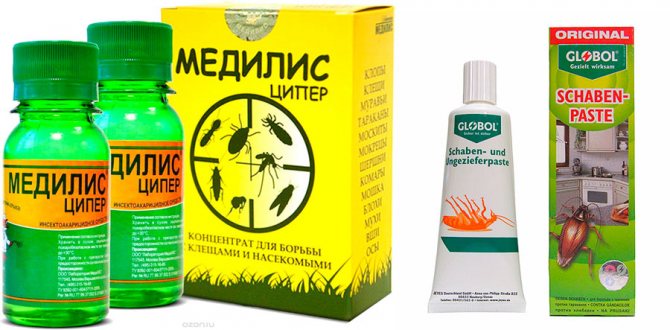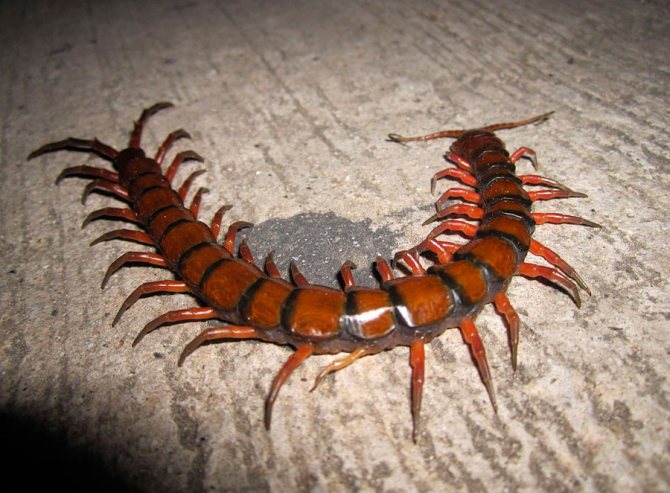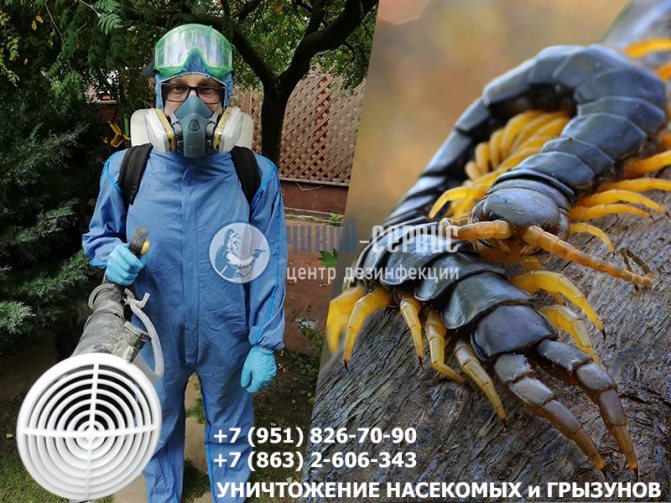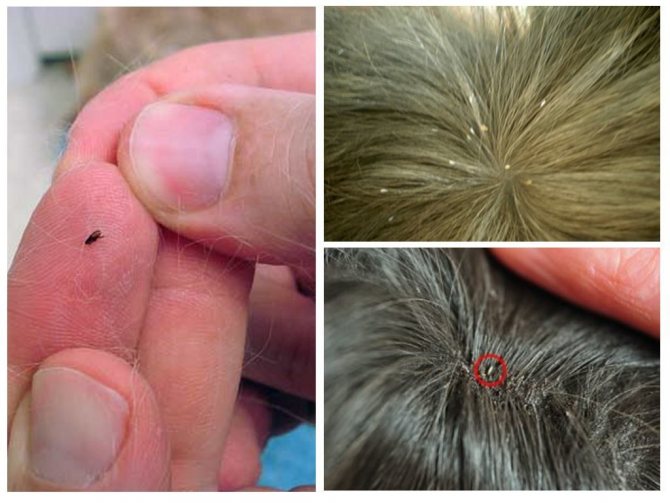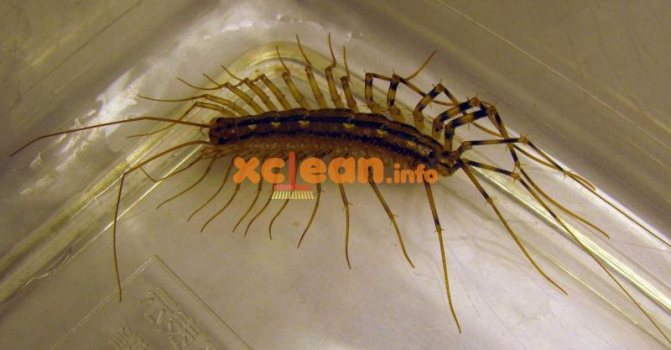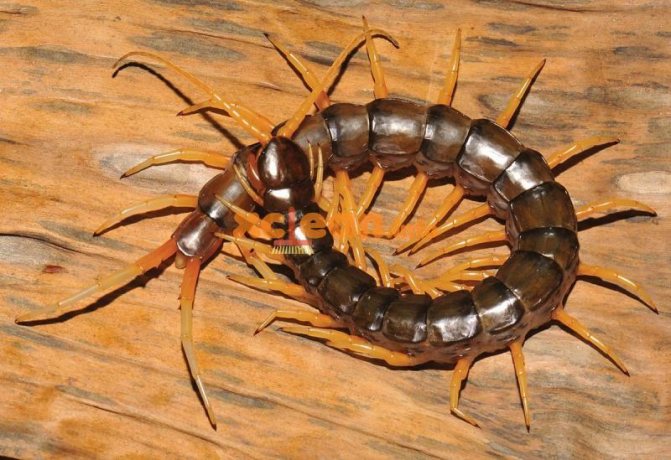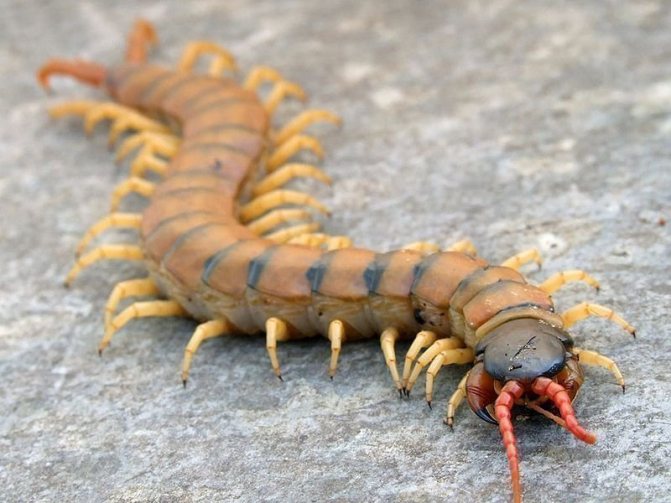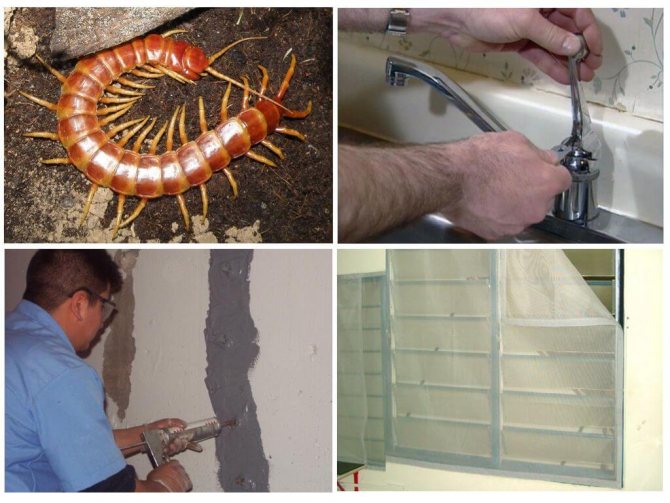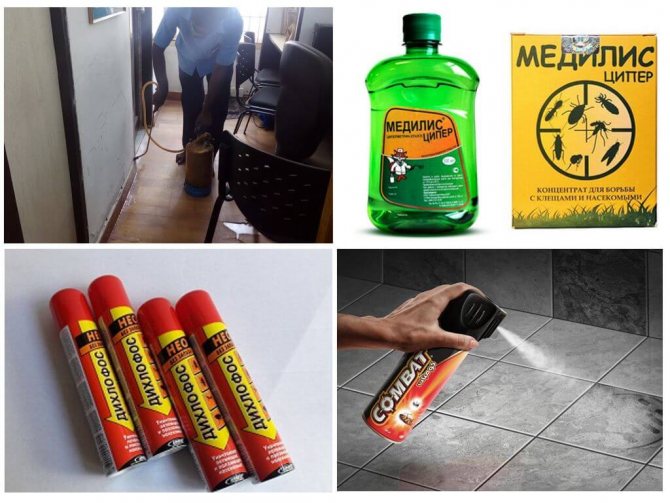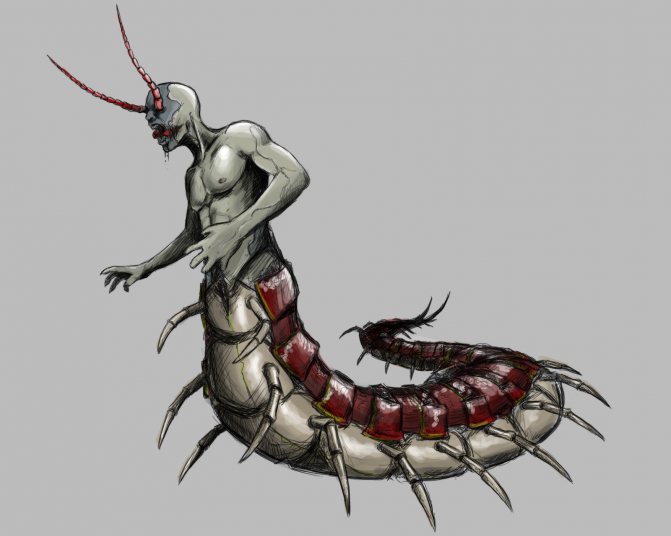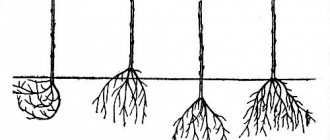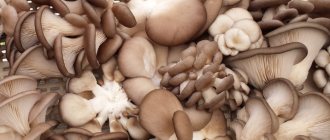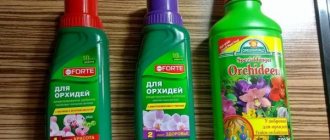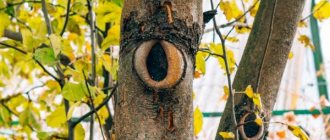Few people can call the neighborhood with centipede pleasant. When this creature starts up in the house, many simply panic. Against its background, even cockroaches look much prettier. And even despite the fact that these centipedes with a long body mostly live in humid forests, sometimes they still climb into residential buildings and stay there for a long time. And here it is necessary to clearly know how to deal with scolopendra, since by no means any method used to destroy the domestic insects we are used to is capable of approaching.
Home content scolopendra
For breeding scolopendra in captivity, terrariums are used. This is a very mobile insect and at the same time aggressive. They live in captivity for up to seven years. If there is no experience in breeding scolopendra, then it is best to study the literature and research all safety techniques for keeping and breeding them.
Scolopendra has a flexible pleural area. Thanks to this fact, it can squeeze into the smallest cracks of any rocks and soil in order to hide safely. This centipede is the greatest escapist.
When choosing a terrarium, pay attention to length, width and height. Read the breeding guides there for the most complete information on such necessary things as buying a terrarium for scolopendra.
The soil should be moist and suitable for burrowing. Humidity should be sufficient, but should not be too wet.
Scolopendra are aggressive, but if you add crustaceans wood lice, they will not touch them, since they do not perceive them as food.
Basically, for all types of scolopendra, a temperature of 27 degrees is suitable. If you get a special species, consult a specialist well about the temperature and conditions of detention.
At home, it is advisable to feed the scolopendra with grasshoppers or mealworms, it is not recommended to overfeed. Usually they are fed 1-2 times a week. Scolopendra up to 15 cm in size will be saturated with 5 crickets. Lack of appetite may mean that the insect is not hungry or is preparing for the next moult.
Precautions
To avoid being bitten by this insect, you need to carefully examine your bed before going to bed. You should pay attention to the fact that small centipedes can hide even in clothes, so things must be shaken out every time before putting on.
As mentioned earlier, in the case of independent use of chemicals, it is necessary to use personal protective equipment. After you have poisoned the insects, you should also ventilate the living area, and wipe the surfaces in the house with a damp cloth.
Collision with scolopendra
Giant centipedes, characterized by an aggressive disposition and toxic poison, are found in the tropics and subtropics. Residents of the temperate zone should not be afraid of a collision with a 30-centimeter giant, which can easily kill a small snake. In Europe, there are individuals that are half the size of representatives of tropical species. How is scolopendra dangerous to humans? The bite of a poisonous millipede is very painful. In most cases, the dose of injected poison is small; it cannot kill or paralyze an adult. Children are in greater danger, their bodies have still formed a strong protective immunity.An attack by a large individual on a child can lead to serious consequences.
On the territory of Russia, scolopendra are found only in several regions - Crimea, the Caucasus, the Rostov region and the Krasnodar Territory. It is inhabited by small centipedes of 12-14 cm. It is a ringed centipede. She is nocturnal; at dusk she goes hunting for insects and small lizards. The view is not aggressive, but you should be careful during overnight hikes. A centipede can crawl into a tent or sleeping bag
You should also be careful when picking branches for a fire. Accidentally disturbing a centipede will get a bite comparable to the sting of 20 bees
The effect of the poison is not fatal, but extremely unpleasant and painful. The claws on numerous limbs leave red spots on the skin if the arthropod is simply run over the body.
What to do with a millipede bite?
When bitten by a scolopendra, the following symptoms may appear:
- burning sensation at the site of the bite;
- the appearance of redness;
- swelling of the skin;
- an increase in body temperature up to 38-39 °;
- weakness;
- dizziness;
- nausea.
Most of the attacks take place in the tropics and deserts. After a bite, people develop inflammation, tissue necrosis, kidney failure, heart failure, and swollen lymph nodes near the site of the bite.
Symptoms can last for up to two days. Of course, in Russia there are no such large individuals in their natural habitat, but do not forget that some give birth to giant scolopendra as pets, so there is always a danger of a scolopendra bite.
If you have such a scolopendra in your house, then when transplanting from the terrarium, it is not recommended to touch it with your bare hands, you need to use special forceps.
So, if you are bitten by a scolopendra, then the poison will quickly penetrate the bloodstream and spread throughout the body. To slow this process down, it is recommended to place a tourniquet above the bite.
After that, it is necessary to treat the wound with ethyl alcohol or an alkaline solution of baking soda.
If after a fever appears, numbness of the limbs, difficulty breathing or clouding of thoughts, then you should immediately consult a doctor.
The bite of the Vietnamese centipede is also dangerous. It leaves a wound up to 1.5 cm in size and up to 0.5 cm deep.Within a few hours, the limb, which was bitten by the centipede, doubles, blood begins to flow from the wound, since the poison contains substances that slow down clotting blood. After that, the body temperature rises to 39-40 °. The victim should be given an antihistamine and see a doctor.
Another problem that a scolopendra bite can cause is wound infection. This is due to the ingress of animal food residues that have rotted in the jaws. Therefore, the wound must be treated with a disinfectant (hydrogen peroxide, alcohol tincture) or at least rinsed with soap and water.
If a scolopendra bites a child, a pregnant woman, an elderly person, an allergy sufferer or a heart, then an urgent need to go to the hospital, because in this case, the outcome can be tragic, even fatal.
Treatment of a scolopendra bite at home
Of course, with a strong rise in temperature, numbness of the limbs, nausea and other serious consequences of a millipede bite, you need to see a doctor. But if the bite is not so severe, then you can treat it at home.
In this case, the wound needs to be rinsed and then a sterile bandage applied.
The bite is painful; pain can be relieved with ice compress and pain relievers.
The patient needs peace, you also need to drink plenty of fluids, it will help speed up the process of removing toxins from the body. It is recommended to additionally drink medicine for allergies.
Scolopendra is a rather dangerous animal, the bite of which will not kill an adult, but it can cause a lot of inconvenience. When meeting with a centipede, you do not need to try to pick it up, most likely it will run away on its own. If she has bitten you, then be sure to treat the wound, take pain reliever and medicine for allergies, and in case of severe symptoms, consult a doctor.
Folk ways
house ways means scolopendra
So, we now know what an insidious creature this centipede is. And, of course, this insect cannot be left with impunity to live in front of us, endangering us and our children. What can be done, because it is unlikely that the centipede will succumb to persuasion to "move"? And by the way, pets are not your help here either.
The dog or cat has not yet been born that could bite through the hard chitin of the centipede. But there are more effective ways to expel an unwelcoming guest. It is possible to urgently cement all holes and crevices in the house so that not a single insect can get inside. True, there is one "but" - the owners will also not be able to get inside such a dwelling, and this is a big minus.
Therefore, you should look for more options.
As you know, scolopendra lives in a humid environment, therefore, in order to get rid of the nasty centipede, it is necessary to reduce the humidity in the house. It would seem that this is the way out! But here, too, there are some nuances. It is not easy to get rid of moisture if it already exists.
In general, sadly, but if you live in areas of high humidity, you need to think about scolopendra in advance.
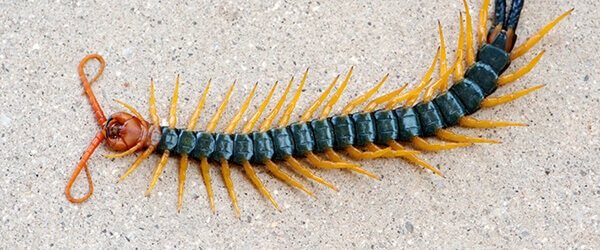
Announcement of Scolopendra in the house: an unpleasant surprise
We talked about prevention. But what if the enemy has already made their way into your territory? First you need to say what you shouldn't do. You should not grab the “animal” with your hands, even if you really want to (well, you never know, what kind of extreme people are there?). In general, you can get rid of scolopendra in two ways:
- way of expulsion from home
- method of pinpoint impact with a heavy object
The first method is risky, because you will have to grab a jar and chase the centipede throughout the apartment, trying to cover it with this object. And this, you know, is fraught with blows and falls.
But scolopendra is even more dangerous, therefore, if you already decided to use the first method, you will have to endure all the "side effects". So, after covering the scolopendra with a jar, read a couple of mantras for good luck over it (you can sing a lullaby, suddenly fall asleep), then carefully close the jar with a lid, take it out into the yard and bury it.
If you don't have a yard, the toilet will do (just don't forget to flush it, otherwise the wild insect may get out).
The second way is even more risky. The fact is that you can't just kill a centipede. We are as accustomed to: a cockroach ran, and we, rrrraz, and a slipper. Two seconds to kill! Our scolopendra has such a hard shell that we need a super-slipper here. And super-slippers are not given to everyone. Therefore, upon seeing a centipede, it is advisable to take possession of something heavier.
This is where the fun begins. You still need to get into the scolopendra. They very deftly dodge with all their numerous legs. But this is not the worst thing. If you don't get into the scolopendra the first time, but, for example, get on the TV, then something heavy after that will get you ... from the household.
On the topic How to get cockroaches out of an apartment
The above methods are so far the most effective ones. No poisons, insect repellents and sprays will make the insect leave - it is resistant to these agents.
If you have not managed to get rid of the centipede after all the measures taken, then there are only two measures that can be taken. The first is to move all pieces of furniture from the walls by 10-20 cm so that the centipede cannot climb on them while you are sitting or lying there.And the second is to move to another place. True, not everyone will go for such drastic changes, but as an option ...
All clean and comfortable home! Bye Bye!
You can also fight the pest with the help of folk remedies. For these purposes, some people take the well-known boric acid, which is used in the fight against many domestic insects. However, it is worth paying attention to the fact that scolopendra is considered a predator, so it cannot be said with certainty that boric powder will attract her attention. If scolopendra enters the apartment through the ventilation, then the grate must be treated with boric acid.
Another unusual folk insect control method is the preparation of food baits based on chemicals. For example, if you have Prusaks at home, you can mold balls to kill cockroaches. When a centipede eats poisoned food, she herself will die.
How to deal with scolopendra?
Scolopendra is a type of centipede. The circle of habitat is located in areas where there is high humidity and warmth. There are about 90 varieties. They have sharp poisonous fangs. They do not bite, but sting in a peculiar way.
Interesting fact: they have an odd number of legs. Depending on the species, they can have up to 350 legs. The most gigantic centipedes have a body length of 30 cm and live in Australia.
Description.
Home scolopendra is also called a flycatcher. Has a terrifying look. In size they reach 55 mm. The color is yellowish-brownish with stripes along the body. Despite the large number of legs, only the last pair is the longest. They love to move around the house at night. Has a high movement speed. The first pair of legs reorganized over time and began to replace the jaw to capture prey.
Interesting fact: the insect has its own way of thinking. When he catches several insects, he feeds on one, and does not let go of the rest, keeps in his paws.
Where do they come from?
Scolopendra reaches 55 cm in size
The basic instincts of this insect are food. Make a survey of your home, because they feed on house insects (bugs, spiders, cockroaches ...). If this food is in abundance - this is the reason for their presence in the house. They like to live in damp and warm rooms, for example: basements, closets, bathrooms. Where do they penetrate from:
- sewer joints;
- from cracks in the walls;
- ventilation;
- from under the concrete slabs.
Harm.
Scolopendra bites are harmful not only to humans, but also to pets (they are hard to tolerate). In people who suffer from chronic allergies, severe complications appear on the scolopendra bite. They have venom in their fangs, which is similar in composition to that of a scorpion. The bites are painful and subside within two days.
Bite symptoms:
- at the time of the bite, a sharp, prolonged pain occurs;
- body temperature rises;
- weakness of the body appears;
- numbness appears;
- the skin turns red and swelling begins.
Helpful Hint: To relieve the bite, place a heating pad with moderately hot water. You can put ice and drink analgesics.
Why are these technologies so effective?
When it becomes necessary to get rid of scolopendra, you need to act quickly and accurately. SES specialists recommend using professional technologies in the house. Hot and cold mists have high penetrating power. They settle on the entire surface of the room to be treated and penetrate into hard-to-reach places: under the baseboards, behind furniture, in the corners of the room - where the scolopendras hide. This allows you to kill insects after the first treatment.
The sanitary and epidemiological station specialists remind that the disinfection of the premises must be carried out with strict observance of all norms.
How to get rid of scolopendra in the house?
You should not take a meeting with a centipede in your own home as an exceptional and isolated case. The appearance of one individual is a signal that several more lurking somewhere nearby.
How to start "evicting" scolopendra from home? First of all, you need to inspect all the typical places of their accumulation. These insects prefer secluded corners and can climb into any crevice, so the kitchen and bathroom will have to be searched, as they say, "with passion." Although scolopendra are so large that it will not be difficult to spot them.
Some people prefer to poison them with their own hands with insecticidal agents. This is not a very effective way: to poison a scolopendra with a toxic spice like "Dichlorvos", it will take at least 10 minutes to spray it. Although for a city apartment, where centipedes rarely get, this method may work.
The most effective way to get rid of scolopendra in your home is to call a disinfection service. The arsenal of these specialists includes various means: they can fumigate a room with smoke preparations, apply chemical compounds or thermal effects. At the same time, these procedures will destroy other domestic insects. By the way, it is their active reproduction that often becomes the main reason for the "settlement" of centipedes in the house.
What to do to prevent centipedes from starting up in the house?
Dry, clean and bright rooms are completely unattractive for scolopendra. Therefore, the most important measure of protection against them is the fight against high air humidity and dampness. The premises should be regularly ventilated, and no moisture stagnation should occur under the bathroom and sink in the kitchen.
You will also have to take care that there are not even small gaps between the walls and the floor, since scolopendra are extremely flexible and able to crawl into any gap. All openings in the floor must be sealed with polyurethane foam. Insects can settle under linoleum and baseboards if it's damp enough. In this case, there is only one way out: remove the coating and dry it thoroughly.
Scolopendra often enter the house from the street through open doors and windows. Therefore, at least at night, it is advisable to close the front door, and put mosquito nets on the windows. It is also recommended to install small grilles on the ventilation holes, and purchase special plugs for the drain holes.
As a rule, centipedes enter a private house from the yard, where they already have a permanent habitat. Heaps of fallen leaves and cut grass, debris heaps are typical places of their accumulation, which should be removed.
Features of the
Outwardly, scolopendra resembles a worm, which has many developed limbs, just like a centipede. Moreover, the first pair of legs performs the function of ticks, which the insect uses to capture prey. At the end of each leg there are thorns impregnated with poison. The body length of individuals can reach up to 10 cm. The color of the body divided into segments varies from light to brown-black tones.
The habitat of millipedes is warm, damp places, from which they get out in search of food only in the dark. Mowed grass, a pile of fallen leaves or debris are favorite places for scolopendra accumulation.
On a note!
Scolopendra are also looking for similar shelters in the house, giving preference to wet places: a bathroom, a bathroom or a kitchen. Insects enter it through open doors and windows, as well as through cracks and crevices in ventilation and sewer systems.
How to get rid of scolopendra: effective methods
There are a number of simple, affordable and effective methods for getting rid of this insect. Firstly, you need to take care of a normal microclimate in the home, making sure that there is no high humidity in the kitchen, bathroom and other rooms. The insect should not be destroyed, since there is no harm from it, but only benefit.Secondly, it is better to analyze the situation and think about what kind of insects the centipede is interested in. If she is deprived of food, then she herself will leave the home. It is better to throw all your strength into the fight against harmful and dangerous insects than to get rid of safe and useful creatures. Since the insect is not interested in food debris, but eats exclusively on insects, it is not so easy to deal with it, and on the other hand, it makes no sense.
General rules
To get rid of home scolopendra is permissible exclusively by ecological methods. For example:
- Dry the rooms, getting rid of high humidity. In addition, you should not allow stagnation of air masses, for which you need to regularly ventilate the room and monitor the operation of the ventilation system.
- Repair all taps and water supply and sewerage systems, eliminating condensation formation on them.
- Regularly get rid of moisture on the walls, and even more so from mold.
- Seal up any gaps to keep insects out of their paths.
- Use polyurethane foam to get rid of gaps between walls, windows, doorways, etc.
- The area around the house should not have accumulations of debris, since centipedes like to breed in such places.
- It is imperative to get rid of various insects that are included in the diet of scolopendra.
Application of insecticides
There are a small number of remedies for centipedes. Therefore, funds are chosen not only to combat centipedes, but also with other types of parasites.
It is very important to follow all safety precautions when using insecticides. It is imperative to protect the face, hands, and other parts of the body from the effects of chemicals
- Medilis-Ziper is a product that must be diluted with water. After that, problem areas are treated with a spray bottle.
- Starex, a spray that works well for crevices.
- Raid aerosol has a pleasant aroma. The product is not toxic to humans, so you do not need to leave the room.
- Henkel Combat, in a special packaging that allows it to be used for the treatment of hard-to-reach areas. Differs in the presence of a strong odor.
- Globol Original, available in the form of a paste, based on deltamethrin and diflubenzuron. The product is toxic, so it should be applied to the surface where children and pets cannot reach.
For those who have a negative attitude to chemicals, a product based on natural pyrethrin is available.
Folk remedies and recipes
It is not always possible to use chemicals. This is especially true when small children, expectant mothers, as well as people prone to allergies live in the house.
Boric acid
Boric acid is used to control many types of insects. It is used both as a powder that simply crumbles in problem areas and as bait based on boric acid. Unfortunately, the centipede will not be interested in baits, but it can eat a poisoned cockroach and can also be poisoned. Better, of course, if some cockroaches are poisoned, then the centipede will leave the house and start looking for another place where there is something to profit from.
The use of hot pepper and diatomaceous powder
They are used in the same way as boric acid powder. If the centipede runs over the powder, then death awaits it. A lethal outcome is also possible when she eats a poisoned insect.
Professional help
Most likely, in the fight against centipedes, you will hardly have to turn to professionals for help. Most likely, such services will be required when it is not possible to get rid of cockroaches or other parasites that feed on centipedes. Special services use various methods of struggle, such as:
- Exposure to temperature.
- The use of microcapsules with synthetic pyrethroids.
- The use of toxic substances.
As a rule, one treatment is enough to prevent centipedes in the house. This, of course, is good, but such a service costs a lot of money.
Preventive measures
Nobody canceled preventive measures in the fight against "uninvited guests". Be on guard for your own home and follow some safety rules.
What are they:
- if you find these arthropods in your home, you should not walk around the house without slippers;
- check pajamas and bedding for centipedes before bed, as these creatures activate at night;
- since scolopendra do not settle in houses in large colonies, throwing only 1-2 representatives out into the street or placing in an airtight container, you can already sleep peacefully;
- connect a pet, such as a cat, to the elimination of the "tenants", as it can perfectly cope with this task;
- thoroughly ventilate and dry a damp room, and then a predatory arthropod will bypass your house on the tenth road;
- do not allow water to accumulate in the sink and bathroom;
- Before building a new home, carefully consider the ventilation system so that condensation does not accumulate in the rooms.
Now you know many of the subtleties and secrets of a successful arthropod extermination operation. We sincerely hope that this information was useful to you. Having received the necessary knowledge in theory, you can easily proceed to the practical part.
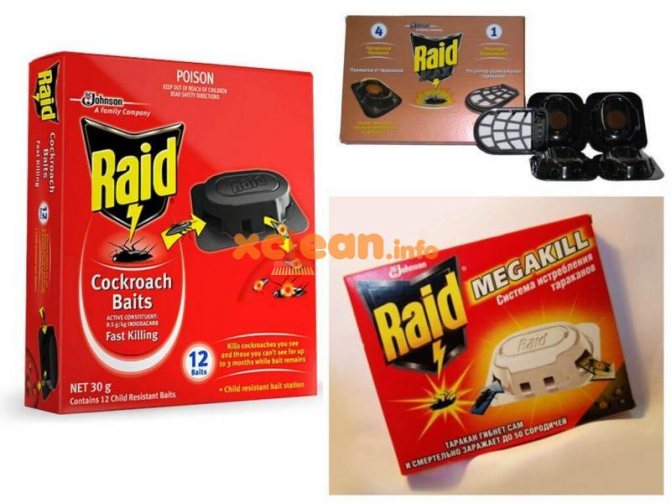

Kivsaki: large and small centipedes
In your garden or in your garden, you can see a centipede that looks like a worm. In Russia, it is small in size, but the inhabitants of the tropics reach a length of about 30 cm. This kivsyak is a representative of the class of two-legged centipedes. A feature of their structure is the presence of two pairs of legs on each segment of the body. Kivsaki are close relatives of insects, but still belong to animals. Scientists have described more than 8 thousand species. Most of them live in Asia, North Africa, Australia. But even in temperate latitudes, representatives of this family feel great. In the vast family of kivsaki, three orders are distinguished:
- Julida - Yulids or real kivsyaks live in Asia and Europe. The length of their bodies corresponds to the width in a ratio of 10: 1, representatives of this species live on the territory of Russia. Centipedes settle in mixed and deciduous forests, meadows, shrubs, and climb into the steppe. In the middle lane, the spotted kivsyak lives, in the south - the Crimean one.
- Spirobolida - This order includes large species of millipedes. They are found in Australia, Africa, Southeast Asia. The average size of representatives is 20 cm. There are individuals with bright colors. Chicobolus spinigerus is a member of the order living in the southeastern United States. Body length from 40 to 90 mm. The color is uneven, the gray color of the back on the sides and abdomen turns into yellowish-beige.
- Spirostreptida - representatives of the order live in the tropical region. They have a large head, and many have developed vision. The total number of species reaches 1000. The largest species is the gigas gigas or Archispirostreptus gigas. The size of adults reaches 38 cm. Under natural conditions, it settles in burrows and forest litter.
Control methods
You should not try to kill the centipede with a slipper or other means at hand. This is almost impossible to achieve due to the fact that her body is covered with a very dense shell. In addition, the dodge of the insect should be taken into account, which greatly interferes with making an aimed strike. It is preferable to catch the centipede with a scoop, brush and rubber gloves. Then take it out as far from home as possible.
Chemicals
You can remove scolopendra in the house using chemicals. For the fight, drugs of a wide spectrum of action are used, designed to destroy various harmful insects. These include:
- Dichlorvos;
- Medilis tsiper;
- Henkel Combat;
- Raid;
- Starex.
When using these insecticidal preparations, personal protective equipment is required: a respirator, rubber gloves and the most closed clothing.
Folk remedies
However, it is not always possible to use chemical agents to combat scolopendra in the house. Therefore, many people resort to more gentle methods of struggle, using time-tested folk recipes. Some sources recommend using boric acid for this purpose, which is used against many domestic insects.
However, one should not forget that scolopendra is a predator, and it is unlikely that baits with boron powder will attract her attention.
Traps
Another method to get rid of scolopendra in the house. All you need to do is place sticky traps where centipedes appear. The result of their struggle will be obvious very soon.
Specialized services
With a large number of centipedes, it is preferable to contact a specialized service, whose employees use professional means to solve this problem.
Comparative table of the best remedies for centipedes
| Product | Impact type | Price |
| Trap | Sticky trap | 59 rbl |
| Insect repellent | Bifenthrin - kills crawling insects | 593 rbl |
| Killing powder | In powder form - harmless to humans | 600 rbl |
| Liquid Insect Killer Cypermethrin | Liquid cypermethrin - up to 90 days | 289 rbl |
Who is scolopendra?
This shell-covered centipede bears a worm-like color scheme. It is dark brownish with a green tint. The habitat of insects is tropical countries. Some species have adapted to temperate climates. It is found in places with high humidity or in the dark. It feeds on various types of insects, beetles, spiders. This animal has the ability to secrete a poisonous liquid, which makes it an excellent hunter. Its poison is especially dangerous in spring and summer.
The fertilization process of a centipede lasts several hours. After breeding, the female does not leave the brood. It is characteristic that during her stay with young animals, she can be eaten by them, or vice versa. The length of the scolopendra living in the apartment ranges between 10 and 15 cm, but there are specimens reaching up to 30 cm.
Prevention measures
If you use some preventive measures, then insects such as centipedes will never appear in the house. It is only necessary:
- Get rid of anything that might be a comfortable breeding ground for these insects.
- If there is a toilet in the yard, it is better to regularly cover it with sawdust and ash.
- Bring the house to a normal sanitary condition so that insects that feed centipedes cannot appear in it.
- Dry all rooms, getting rid of unwanted high humidity, which attracts more than just centipedes.
- Make sure that there are no holes and crevices in the house through which insects can enter the house.
- Use boric acid powder for insect control by scattering it in problem areas.
- It is advisable to close the bathroom and sinks at night with special plugs.
- If the floors are wooden, then it is better to treat them with parquet mastic.
Despite its frightening appearance, which scolopendra scares the household, you should not be afraid of it, but on the contrary, you need to make sure that this insect remains alive. At the same time, one should think carefully why she was interested in housing. It is quite possible that it is time to start the fight with other not invited guests, starting a general cleaning in all rooms.
Scolopendra is a predatory poisonous animal from the family of millipedes. She is known for her unusual appearance, which causes conflicting feelings in people. Most when meeting her are frightened and disgusted.But there are lovers of exotic animals who keep them in home terrariums, and even let them run around the apartment. Is scolopendra dangerous to humans? She will not be able to cause significant harm to her health, but her bite will deliver a lot of unpleasant sensations in the form of pain and malaise from the poison.
Why is it dangerous?
Why is centipede dangerous for humans? In fact, if it is not attacked, then the centipede will not show aggressiveness. In extreme cases, it can bite hard, releasing poison. Getting a scolopendra out of the house can be difficult. Within the framework of this section, we will try to figure out what harm the centipede can inflict on people.
Arthropods that live in the northern latitude are not as poisonous as their Crimean counterparts. The latter can be dangerous for babies, people with weakened immune systems and allergy sufferers. After the scolopendra runs over the human body, a burn may remain on this area of the skin. Burning mucus from the front pair of legs is capable of leaving an imprint. After contact of an arthropod with human skin, redness remains on the body without serious complications. In rare cases, there are exceptions. A dangerous poison in this creature is secreted for self-defense purposes. It is intended for those insects that hunt wood lice. Among the "enemies" are lizards and small rodents.
Scolopendra Crimean after a bite is unable to poison a person with its poison. However, after the arthropod leaves burning mucus on the skin, the health of the bitten person will suffer a little. A person can have a high temperature for several days (up to 39 ⁰С), and the place of the burn swells and itches a lot. In addition, the site of the bite is very painful. A person can stay in such a state for 2 days, and after the patient's health is on the mend. You do not need to self-medicate, but you should seek help from the hospital. Persons with weakened immune functions of the body and diseases of the cardiovascular system are at a special risk zone.
In fact, scolopendra are not as aggressive as they might seem at first glance. But they are very shy creatures. For no apparent reason, woodlice will not attack people. Only in case of danger can they sting their victim.
Very good reasons are needed for the centipede to "use" its poison. If a person accidentally or deliberately steps on an arthropod or touches it with his hand, then the burning secret will be released involuntarily. A person affected by the poison of scolopendra needs to wash off the trail of sticky mucus on the skin, only by putting on gloves on his hands.
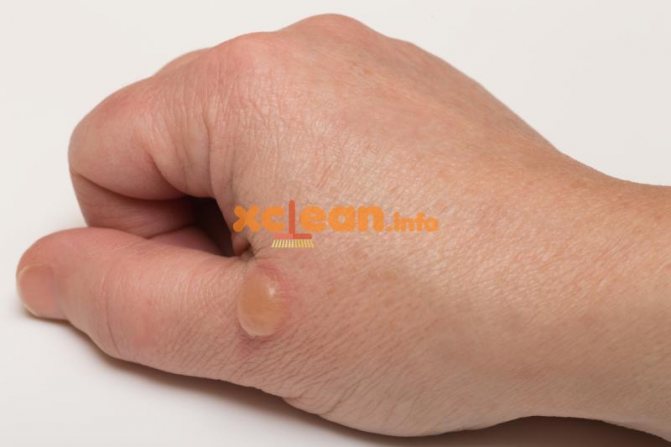

General information about the insect
Scolopendra belongs to the family of tracheal arthropods. There are about 90 species of centipedes in the scolopendra detachment. Most of them prefer to live outdoors, in places with increased dampness (under fallen leaves, bark). Only the domestic centipede prefers to live in the house.
The insect has a body 2-4 cm long (sometimes up to 6 cm) with a yellowish-gray or brown color. On the back of an adult insect, there are three bluish or purple stripes. Long antennae and compound eyes provide the centipede with good vision and spatial orientation. The body is flattened, divided into 15 segments. Each of them has 1 pair of legs. The first pair evolved into mites. They serve to capture prey. Scolopendra injects paralytic poison into the victim and immobilizes it.
The domestic centipede is a predatory insect. She eats flies, cockroaches, bedbugs, ants and other insects. In the houses, the scolopendra goes hunting at night. At the same time, she can catch several insects and slowly eat them one by one.
The female insect lays eggs in the summer in an amount of up to 35 pieces. To do this, she chooses damp and warm places in the house (behind the baseboard, in the bathroom).Young insects have only 4 pairs of legs. In the process of growing up, their number grows. Scolopendra grow throughout life. If legs are lost, they can grow back.
Insect varieties
There are several dozen species of scolopendra, the main similarity of which is the general features of the structure and a large number of limbs. The giant centipede lives in South America. Due to its large size, small rodents, amphibians and birds can become its victims. The jaws of this centipede are poisonous, an insect with its bite can harm a person (weakness, swelling and pain).
Scootiger usually has a yellow-gray body and long, striped limbs. Its length is about 6 centimeters, it feeds on arthropods and lives in Africa, Kazakhstan, the Caucasus, in the southern part of Russia - in countries with a warm climate. She often lives in fallen leaves, but with the onset of cold weather seeks a warm refuge.
In winter, a scolopendra scooter can end up in a person's dwelling. She is not able to bite through the skin, but her bite can be compared to a wasp. Also, the scooter does not harm furniture and does not spoil food supplies, therefore in some areas it is considered a useful centipede that eats pests. In the photo below you can see what this type of animal looks like.
Ringed species are found in southern European countries and are about 15 centimeters long. It is a dexterous predator that eats arthropods and small reptiles.
What to do if bitten by a centipede?
The bite of this predator is extremely painful. Negative symptoms begin to develop immediately after the attack. They are usually more pronounced in a child than in an adult. After a scolopendra bite, you must immediately provide the victim with first aid. Correct actions will stop the further deterioration of the clinical picture and prevent the development of severe consequences of a scolopendra bite.
Symptoms of a ringed scolopendra bite
Not always a person can understand that he was stung by a centipede, because he can simply step on it and not notice it. The first thing that the victim feels after the bite is acute pain and burning. The predator, digging into the skin, leaves 2 small punctures, similar to needle marks.
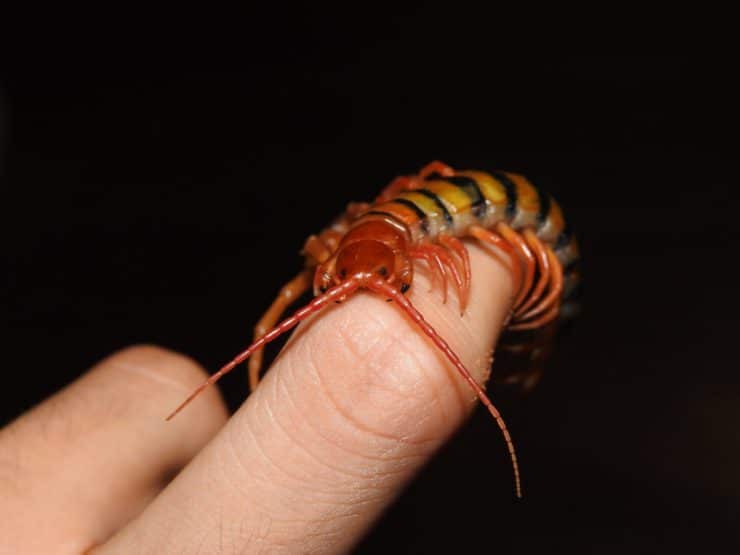

It is believed that the venom of scolopendra annelids is not so toxic as to lead to paralysis and death of a person. In most situations, the symptoms of its entry into the human body are more unpleasant than dangerous. However, in any case, especially if a child is injured, they require immediate medical attention.
You can understand that it was the centipede that bitten by the following signs:
- redness at the site of the bite;
- swelling in the affected area;
- increased body temperature and blood pressure;
- deterioration in general health: weakness, dizziness, headache, bouts of nausea and vomiting, causeless anxiety;
- violation of the heart rhythm.
These are common symptoms of millipede venom entering the human body. In some cases, against the background of her bite, they can:
- develop an allergic reaction or kidney failure;
- swollen lymph nodes;
- numb tissue in the affected area;
- blisters appear;
- necrotic phenomena occur in the tissues;
- anaphylactic shock or myocardial infarction occur.
First aid and further treatment
What happens after a millipede bite depends on the condition of the victim. Usually, the discomfort disappears after a few days, and in most cases, medical attention is not required. Allergy sufferers and parents of bitten children should be especially vigilant.
The first thing to do after being attacked by a predator:
- thoroughly rinse the wound under running water with laundry soap - it is recommended to do this for at least 10 minutes in order to completely remove the poison from the wound;
- treat the lesion site with an antiseptic composition (potassium permanganate, furacilin solution);
- apply a sterile bandage;
- put the victim to bed and give him frequent water.
For relief of painful manifestations, the following are shown:
- taking pain medications;
- the use of antihistamines;
- applying ice to the bite site;
- the use of antibacterial agents when symptoms of infection appear;
- the introduction of anti-tetanus serum if necessary.
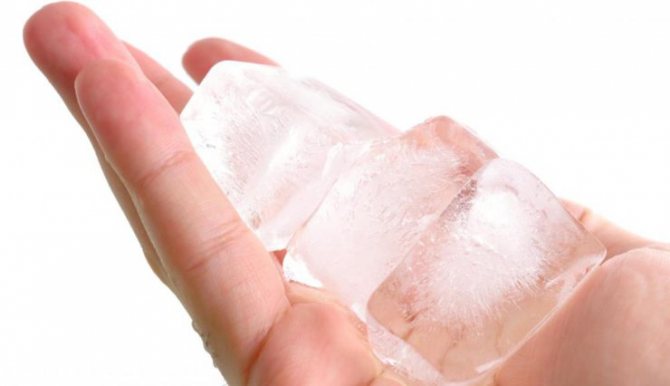

With a millipede bite, you cannot:
- cauterize the wound;
- to impose a tourniquet - this will not prevent the spread of scolopendra poison throughout the body, but it can lead to blood stagnation, tissue death and the development of gangrene;
- try to suck or otherwise remove the poison;
- take alcohol-containing drinks - alcohol accelerates the absorption of toxins.
The victim needs attention within 2-3 days after the millipede attack. If he has a fever, the functioning of the respiratory system has worsened, convulsions have appeared, you must immediately call an ambulance or take him to the nearest medical institution on your own.
Description
As you can see in the photo, the home scolopendra has an elongated body of yellowish-gray or brown color, decorated with three dark stripes. Moreover, its dimensions can be from 3.5 to 6 cm.
The external, or external, skeleton consists of sclerotin and chitinous cover. The body has a flattened shape and is divided into 15 segments, each of which carries a pair of legs. The longest walking limbs are the latter.
It is the last legs, because of their appearance, that often make it difficult to determine where the flycatcher's head is. The front pair of legs is well developed - with them the centipede captures prey and attacks the enemy.
The head has faceted eyes and long 600-segment whiplike antennae
The body structure of young flycatchers is somewhat different. They have only four pairs of walking limbs. Their number increases with each molt - the domestic centipede after each molt acquires several legs: first there are 10 of them, then 14, 18 and 26. After the last change of the chitinous cover, the number of legs reaches 30.
Lifestyle and behavior
Scolopendra home is able to remain active at any time of the day. She moves at an enviable speed - about 40 cm / sec. When moving, the flycatcher raises its long body above the ground and deftly rearranges its numerous legs.
A pair of faceted eyes are quite well developed, which allows this scolopendra to easily detect its prey. For this reason, she is an excellent hunter.
Sitting on the wall, the flycatcher is waiting for prey, ready to pounce on any unwary insect at any moment
As for the taste preferences of this centipede, it can eat:
- flies and their larvae;
- crickets;
- worms;
- silverware;
- snails;
- fleas;
- cockroaches;
- moth;
- ants.
The fact that a potential victim is nearby, the domestic scolopendra is "informed" not only by the eyes, but also by long, hypersensitive antennae, which are capable of recognizing both touch and smell. As soon as the prey is in its paws, the flycatcher immediately plunges its fangs into its body and injects poison. And after the meal, she tries to hide in a dark place and wait until the food is absorbed.
Make no mistakes!
When a scolopendra is found, quite a few try to get rid of it in ways that, in practice, do not bring any results, and sometimes can even harm. These include:
- Attempts to "nail down" a centipede with improvised means - neither the newspaper nor the slippers are capable of killing the centipede. This is due to the fact that her body is covered with a very dense shell, which reliably protects adults from such attacks. In addition, she is quite nimble and moves quickly, so it is most likely that it will not work to make an aimed strike.
- Use of aerosols against crawling insects. Since this centipede is not an insect, it is simply useless to use the above means against it.Moreover, it has a much larger size than insects, and therefore the concentration of toxic substances must be quite high, which cannot be provided by such drugs. In addition, scolopendra run very quickly, and therefore it is almost impossible to make a long spraying.
- Using sticky traps. Here, again, the impressive size of the centipedes will interfere. Plus, even if the individual sticks and loses several legs in an attempt to get out, it will run away without much difficulty, and the limbs will soon grow back.
- Attempts to catch it with hands, a can, a bag, etc. This is absolutely impossible to do, since in case of danger, the numerous walking limbs of this creature become poisonous.
Toxicity
Since the Crimean scolopendra prefers to lead a hidden lifestyle and is always well disguised, while on vacation, it is quite easy to overlook and disturb it. And since this arthropod is also very aggressive, it will attack at the slightest sense of danger.
Is the Crimean scolopendra dangerous for humans? The venom of these arthropods consists of a set of enzymes that can not only kill the prey, but also digest its internal contents. For a person, this poisonous secret does not pose a mortal danger, although it causes quite tangible pain. After a bite, the affected area can become very inflamed, often the body temperature rises, chills and aches appear.
As a result, carelessness can turn into a heavy retribution - a malaise that will last for several days. However, usually all symptoms disappear after 2-3 days.
But not only the bite of the Crimean scolopendra causes painful sensations. At the moment of fright, this arthropod secretes a sticky substance, upon contact with which you can feel a strong burning sensation and itching. In addition, this secret, when it comes into contact with the skin, can provoke an allergic reaction.

